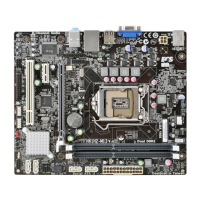
Do you have a question about the ECS H61H2-M13 and is the answer not in the manual?
| Form Factor | Micro ATX |
|---|---|
| Socket | LGA 1155 |
| Chipset | Intel H61 |
| Memory Type | DDR3 |
| Memory Slots | 2 |
| Maximum Memory | 16 GB |
| PCI Slots | 1 |
| SATA Ports | 4 x SATA 3Gb/s |
| LAN Chipset | Realtek RTL8111E |
| LAN Speed | 10/100/1000 Mbps |
| PS/2 Ports | 1 x PS/2 Keyboard, 1 x PS/2 Mouse |
| Memory Standard | DDR3 1333/1066 MHz |
| USB Ports | 8 x USB 2.0 (4 rear, 4 via headers) |
| Audio | Realtek ALC662 6-channel HD Audio |
| Video Outputs | 1 x VGA |
Provides an overview of the motherboard, its capabilities, and key features.
Provides a detailed introduction to the motherboard and its main features.
Details the CPU socket, chipset, and additional chips like PCI bridge.
Describes optional onboard LAN features and available expansion slots.
Provides comprehensive specifications for CPU, Chipset, Memory, Expansion, Storage, Audio, LAN, I/O, BIOS, AP, and Form Factor.
Illustrates and labels the physical components on the motherboard.
Lists and describes each labeled component on the motherboard.
Details technical specifications and identifies physical components.
Lists memory support (DDR3) and audio codec features.
Lists integrated I/O ports and the functions of the BIOS firmware.
Covers safety precautions, choosing a compatible computer case.
Guides on processor installation, cautions, and overclocking procedures.
Provides a step-by-step guide with illustrations for CPU installation.
Explains how to install DDR3 memory modules, including handling precautions.
Details the step-by-step process for installing memory modules into slots.
Describes the PCI Express and PCI slots and their usage for add-on cards.
Provides instructions for installing expansion cards into the motherboard slots.
Explains connections for front panel USB headers and onboard serial port.
Guides on connecting SATA cables and power for hard drives.
Explains how to connect PS/2, VGA, LAN, and Audio ports.
Guides on connecting CPU fan, power supply, case switches, and speakers.
Guides on physically mounting the motherboard and configuring jumpers.
Details the installation process for the CPU and RAM modules.
Covers expansion slots, connecting optional devices, and I/O ports.
Addresses issues like no power, no display, and system shutdown during initial setup.
A visual guide to diagnose common PC startup and display problems.
